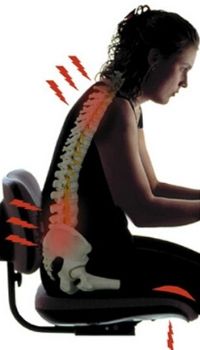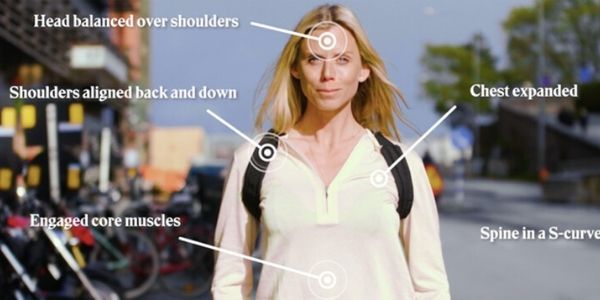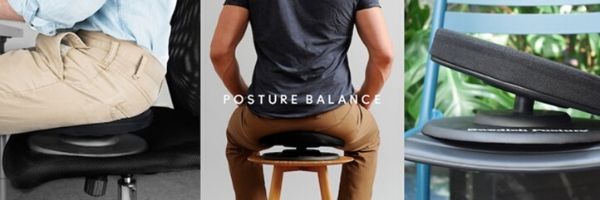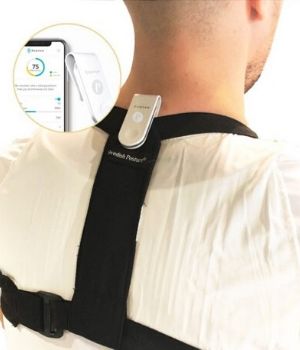Why Do YOU Need Better Posture?
Categories: Healthcare,Latest News
We spend most of our lives sitting down. But this sedentary lifestyle can leave us slouching, stiff, and even injured. There are hundreds of reasons why you need better posture, and thankfully, plenty of ways to correct your posture today.
Your parents weren’t lying when they nagged you to “stand up straight” as a teenager. But our parents’ lives and lifestyles were different than our own, sports scientist Ralf Forster told us. As well as advising clients on the importance of good posture, Ralf’s company – Amforca Sports – distributes a range of posture correcting products in the Netherlands, from industry innovators like Swedish Posture.
“These are modern problems,” Ralf said. “50 years ago people were working on the farms, working physically and obviously now it’s more computer work, sedentary work. Everything we do is sitting.”
While it’s tempting to look at our longer lifespans, better diets, and shorter working days as evidence of progress, there’s a wealth of scientific evidence to suggest that spending so much time sitting down is hurting us. Public health organizations the world over have warned that “sitting is the new smoking,” and coined the term “sitting disease” to describe the ill effects of too much time parked on our rears.

“Staff who are sitting the whole day, we see that this results in problems, in health issues, in neck pain, in back pain,” said Ralf. “Their posture changes throughout the years.”
Indeed, neck and back pain are just two consequences of poor posture mentioned by Ralf. Researchers have linked bad posture with a laundry list of ailments. Headaches, knee, hip and foot pain, shoulder pain and impingement, jaw pain, fatigue, and breathing problems can all be triggered by simply sitting down too much. More generally, physical inactivity can increase the likelihood of heart disease, cancer, diabetes, and obesity.
All that cycling keeps the Dutch relatively in shape, yet the average worker in the Netherlands sits for more than seven hours per day, and just over half get the level of physical activity recommended by the World Health Organization. This seven-hour figure is even more shocking when you take into account that it’s the average across all kinds of jobs. Office-bound workers are likely spending far more time in a potentially dangerous position than their counterparts on the construction site or in the warehouse.
For Ralf, it’s not just time spent at the office that’s endangering their health, it’s time spent hunched over smartphones and reclining on the couch after work too.
Even those who go to the gym after work rarely consider their posture, he noted.
“You think, ‘oh yeah, I want to work my upper body,’ but who’s also focusing on the upper back to get the imbalances out? You want to work on your chest, you want to work on your core, you want to burn fat, gain some muscle? But who’s working on their posture?”

Check Yourself
Evaluating your own posture is easy. Stand so that the back of your head, your shoulder blades, and your butt touch the wall, keeping your heels two to four inches (5-10cm) from the wall.
Next, slide your hand behind the small of your back. It should be a tight squeeze between your back and the wall. If there’s too much space, press your spine back against your hand. If there’s too little, arch your back just enough to fit your hand in the gap.
Now, hold this posture and walk away from the wall, and return to see if you managed to maintain it. Chances are, it feels a little difficult to stay upright.

Join the Digital Revolution and Improve Your Posture
The concept of “office fitness” has become increasingly popular in recent years. Being “in the zone,” working for many hours at a time; it’s easy to forget to be mindful of one’s posture and, more importantly, lack of movement. Even though you can have an ergonomic therapist come to your office or home and provide you with all the correct measurements, it’s important to have a diversity of movements throughout the day. New cool and nifty gadgets such as the Posture 8 Sense, will remind and “buzz” you to:
- Measure your posture
- Keep a correct posture
- Move when it’s time to move
- Stand-up and lie down throughout the day
- Stretch
- Walk around
- Remind you of when it’s time to do “office” exercises (don’t worry you won’t sweat)
It’s essentially like an “e-Personal Trainer” (for the office), which you can adjust and get reports through your smartphone in order to keep you office fit!

Active Sitting, Active Standing
Correcting poor posture doesn’t take anything as time-consuming as a full-on workout. Among the products Ralf’s team distributes is Swedish Posture’s Flexi Corrector. Designed to be worn over clothing for one to three hours at a time, this figure-eight strap loops around the shoulders and encourages the wearer to keep their shoulders back, in a healthy, confident position.
It’s not a brace, however, and your muscles will engage to do the work. Manufactured from a combination of stretchy and non-elastic material, the Flexi Corrector both reminds the wearer to improve their posture and strengthens the relevant muscles over time.
“If you’re in the correct position, it should feel comfortable,” Ralf explained. “If you push your shoulders forward it doesn’t feel comfortable anymore and you’re forced to use your muscles to get back into a comfortable position.”
“The body gets more in balance again.”
Swedish Posture’s Posture Balance Seat sits between your butt and your office chair, turning your workstation into a low-intensity core training gym. Essentially, it forces your muscles to make constant micro-adjustments to stay upright. Using this device for just 15-30 minutes at a time can pay dividends to your health, all without even standing up.
“’Active sitting’ is really a new term for many people,” said Ralf. “It’s not an ab workout, like your crunches, but you know you have some activation in the muscles.”

Be Your Best Self
Aside from simply preventing strain and injury, actively working on your posture can benefit other areas of your life too. You’ll breathe easier and use less energy to move, walk, and run, meaning you’ll feel fresher after a long day. You’ll digest food easier, avoiding gut problems like constipation, acid reflux, and hernias.
You’ll also project an image of confidence and composure. You’ll look slimmer, younger, taller, and more authoritative. As social psychologist Amy Cuddy explained, simply getting your posture sorted can “significantly change the way your life unfolds.”
“It’s not just about fitness,” Ralf explained. “It’s also about being representative. Being the leader of a meeting, showing confidence, showing that you know what you’re talking about. You can’t do this in a slouching position.”
You’re probably reading this sitting at your desk, or on your smartphone screen. Why not take the opportunity to take note of your posture? Perform a short ‘audit’ on your body and see where there’s room for improvement. Prevention is better than cure, and the payoffs are immense. Stand up straight and be the best version of yourself today.
